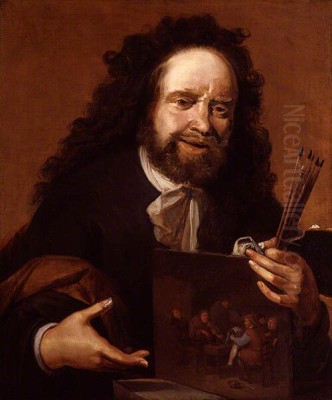
Egbert van Heemskerck the Elder stands as a notable figure in 17th-century Dutch Golden Age painting. Active during a period of immense artistic flourishing, he carved a distinct niche for himself, particularly through his vivid depictions of everyday life, tavern interiors, and, quite uniquely, medical scenes. Born in the vibrant artistic hub of Haarlem around 1634 or 1635, his life and career spanned significant geographical and cultural shifts, moving from the Netherlands to Italy and eventually settling in England, where he died in 1704. His work offers a fascinating window into the social customs, scientific practices, and artistic tastes of his time.
Early Life and Artistic Formation in Haarlem
Haarlem, during the 17th century, was a crucible of artistic innovation, home to masters like Frans Hals and Jacob van Ruisdael. It was into this stimulating environment that Egbert van Heemskerck the Elder was born. While specific details about his formal training remain elusive in historical records, it is almost certain that he absorbed the prevailing artistic trends of his hometown. Haarlem was particularly renowned for its landscape and genre painters, and the emphasis on realistic depiction of daily life undoubtedly shaped Heemskerck's artistic inclinations.
His family background may have also played a crucial role. Some sources indicate he belonged to a family with medical connections in Haarlem, which could explain his unusual and insightful focus on surgical and medical subjects later in his career. Furthermore, art seemed to run in the family. Records mention a Jasper van Heemskerck as a painter and potentially Egbert's father. There is also mention of the significant influence of the earlier, highly renowned Haarlem-born Renaissance painter Maarten van Heemskerck (1498-1574), known for his historical and mythological scenes and his influential trip to Italy. While the exact lineage might be complex or subject to historical confusion, the connection to artistic practice within his family context seems evident.
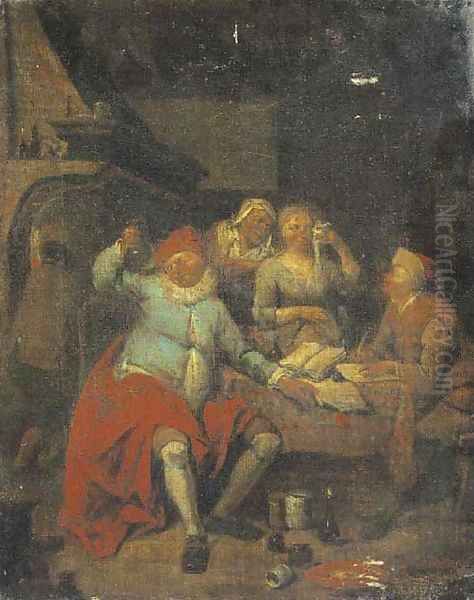
Early influences on his style are often cited as Adriaen van Ostade and Adriaen Brouwer. Both were masters of genre painting, depicting peasant life, tavern brawls, and rustic interiors with a characteristic blend of realism and often earthy humor. Brouwer, though Flemish, worked in Haarlem for a period and was known for his expressive brushwork and keen observation of human character, particularly in less-than-idealized settings. Van Ostade, a Haarlem native, specialized in detailed scenes of village life, often imbued with a warmer, more convivial atmosphere than Brouwer's work. Heemskerck appears to have synthesized elements from these artists, developing his own approach to genre subjects.
Italian Sojourn and Return
A significant chapter in Heemskerck's life began with his marriage in 1654. The following year, 1655, he embarked on a journey to Italy, a common pilgrimage for ambitious Northern European artists seeking to study classical antiquity and the masterpieces of the Italian Renaissance firsthand. He remained in Italy for a considerable period, reportedly six years, before returning to the Netherlands.
This extended stay abroad would likely have broadened his artistic horizons significantly. Exposure to Italian art, from the dramatic compositions of Caravaggio and his followers to the classical ideals of Raphael and Michelangelo, and the architectural splendors of Rome, could have refined his sense of composition, use of light and shadow (chiaroscuro), and perhaps introduced him to different thematic possibilities. While his core style remained rooted in Dutch genre traditions, the Italian experience may have added a layer of sophistication or narrative complexity to his subsequent work. The source material specifically notes he studied classical architecture and Renaissance art, suggesting a deliberate engagement with these traditions.
Relocation and Career in England
Around 1670, Heemskerck made another major life change, relocating to England. He settled in London and remained there for the rest of his life, becoming part of the diverse community of continental artists who found patronage and opportunity in the British capital during the later Stuart period. This move coincided with a growing English appetite for Dutch and Flemish art, particularly genre scenes, landscapes, and portraits. Artists like Sir Peter Lely and Sir Godfrey Kneller dominated court portraiture, but there was a market for other specializations.
In England, Heemskerck continued to paint the types of scenes that had likely brought him recognition in the Netherlands – lively tavern interiors, scenes of peasant life, and his characteristic medical subjects. His works found a ready audience, appreciated for their narrative detail, humor, and sometimes satirical edge. His presence in London also facilitated collaborations, most notably in the field of printmaking.
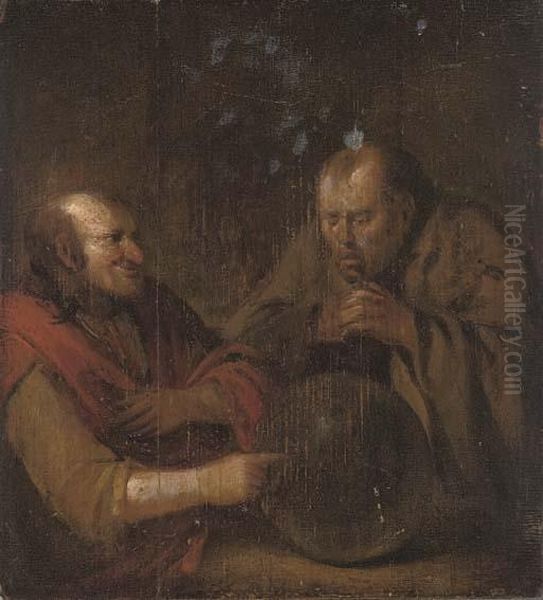
His son, Egbert van Heemskerck the Younger (often dated 1660-1704, though the shared death year with his father raises questions), followed in his father's artistic footsteps. He too settled in England and became known for painting similar genre subjects, often characterized by a robust, sometimes crude, humor and caricature that appealed to popular taste. Father and son reportedly collaborated on numerous works, particularly these "low-life" scenes, which were popular in the London art market. This familial artistic partnership highlights the transmission of style and subject matter across generations.
Artistic Style: Genre, Humor, and Observation
Egbert van Heemskerck the Elder's style is firmly situated within the Northern European tradition of genre painting. He excelled at capturing scenes of everyday life, particularly the boisterous atmosphere of taverns and the rustic simplicity of peasant households. His works often share characteristics with contemporaries like Jan Steen or the slightly earlier Flemish master David Teniers the Younger, depicting gatherings, drinking, smoking, and games with keen observation.
A defining feature of his work, and that of his son, is the infusion of humor and satire. Figures are often depicted with expressive, sometimes exaggerated features and postures, highlighting human foibles and the comical aspects of social interactions. Drunkenness, minor squabbles, and moments of unguarded behavior are common themes. This approach, sometimes referred to as the "low-life" style, was not merely for entertainment; it often carried moralizing undertones, reflecting on themes of moderation, folly, and the transience of earthly pleasures, common preoccupations in 17th-century Dutch culture. His style is distinct from the refined, tranquil interiors of Johannes Vermeer or the formal portraiture of his Haarlem predecessor Frans Hals.
His technique involved detailed rendering of figures, objects, and settings, creating believable and engaging narrative scenes. While perhaps not possessing the subtle atmospheric effects of some Dutch masters, his strength lay in lively characterization and storytelling. The influence of Brouwer can be seen in the dynamic energy of some scenes, while the meticulous detail echoes aspects of Van Ostade's work.
The Unique Focus on Medical Scenes
Perhaps the most distinctive aspect of Heemskerck the Elder's oeuvre is his recurring depiction of medical and surgical scenes. His painting The Doctor's Surgery (often dated circa 1665-1675) is a prime example and one of his most recognized works. This painting offers a dramatic and somewhat unsettling glimpse into the realities of 17th-century medical practice. It typically shows a surgeon, often a barber-surgeon, performing an operation, possibly trepanation or treating a wound, while assistants and onlookers react with a mixture of concern, fear, and morbid curiosity.
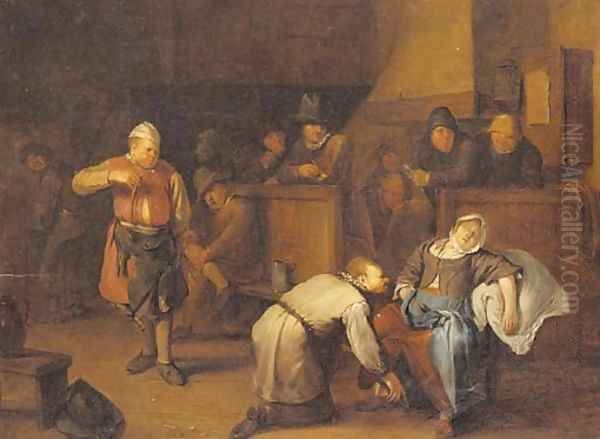
These works are remarkable for several reasons. They demonstrate a detailed, almost clinical observation of surgical instruments, procedures (as understood at the time), and the setting of a doctor's or surgeon's room. The figures' emotional responses are vividly portrayed – the patient's suffering, the surgeon's concentration, the bystanders' apprehension (sometimes including figures covering their faces in distress). As noted in the source material, these paintings reflect not only Heemskerck's understanding of contemporary medical practices but also an insight into the burgeoning scientific knowledge of the era.
Coming from a family possibly connected to medicine in Haarlem likely provided Heemskerck with firsthand knowledge or at least a deeper interest in these subjects. These paintings serve as invaluable historical documents, illustrating the state of medicine before the advent of modern anesthesia and antiseptic techniques. They stand apart from the more common genre themes and highlight Heemskerck's willingness to tackle unusual and challenging subject matter. His approach contrasts sharply with the idealized anatomical lessons painted by artists like Rembrandt van Rijn (e.g., The Anatomy Lesson of Dr. Nicolaes Tulp), offering a grittier, more narrative perspective on medical intervention.
Philosophical and Religious Themes
Beyond genre and medical scenes, Heemskerck the Elder also explored philosophical and religious subjects, demonstrating a broader intellectual range. His painting Heraclitus and Democritus (dated 1695 in one source) depicts the two ancient Greek philosophers who represented contrasting attitudes towards humanity: Heraclitus, the "weeping philosopher," lamenting human folly, and Democritus, the "laughing philosopher," amused by it. This theme was popular among artists, allowing for the exploration of human nature and philosophical viewpoints. The fact that a version of this work later entered the collection of the National Gallery in London attests to its quality and appeal.
He also painted religious gatherings, such as Quakers Meeting. This work provides a fascinating visual record of a Quaker assembly, likely observed during his time in England where the Society of Friends was becoming established. It reflects an interest in contemporary religious life and the diversity of practices outside the established church. Such works contribute to our understanding of the social and religious landscape of late 17th-century England. These thematic explorations show an artist engaged with the intellectual and spiritual currents of his time, moving beyond purely observational genre painting.
Collaborations in Printmaking
Heemskerck's artistic activities in England extended to the realm of printmaking. He collaborated with the English mezzotint engraver Isaac Beckett (c. 1653-1688). Mezzotint was a popular technique in England at the time, capable of producing rich tonal effects suitable for reproducing paintings. One documented collaboration is the print titled The Dutch School, based on a painting by Heemskerck.
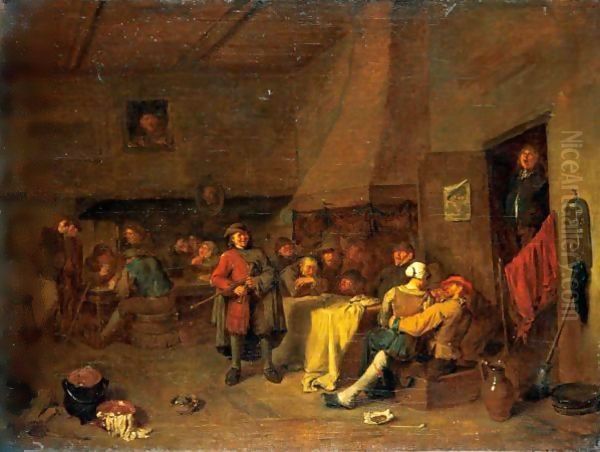
This collaboration highlights the interconnectedness of the London art world, where painters and printmakers often worked together to disseminate images to a wider public. Prints after Heemskerck's paintings would have helped popularize his characteristic scenes of Dutch and English life, further enhancing his reputation and influence. Working with a skilled engraver like Beckett ensured that the tonal qualities and narrative details of his paintings were effectively translated into the print medium. This aspect of his career underscores his integration into the English artistic scene and his contribution to visual culture beyond painting itself.
Legacy and Influence
Egbert van Heemskerck the Elder left a legacy as a skilled and versatile painter of genre scenes, known for his humor, detailed observation, and unique focus on medical subjects. His career path, moving from the heart of the Dutch Golden Age in Haarlem to Renaissance Italy and finally to late Stuart England, reflects the mobility and adaptability of artists in this period. His work provides valuable insights into the social customs, medical practices, and everyday life of the 17th century in both the Netherlands and England.
His influence can be seen directly in the work of his son, Egbert the Younger, who perpetuated his father's style and themes, particularly the humorous and satirical depictions of tavern and peasant life, finding success in the English market. More broadly, Heemskerck's work contributed to the popularity of Dutch-style genre painting in England. While perhaps not reaching the fame of the very top tier of Dutch masters like Rembrandt or Vermeer, or the sweeping historical narratives of Flemish contemporaries like Jacob Jordaens, Heemskerck successfully catered to a specific market demand for lively, narrative scenes. His medical paintings remain a particularly significant and unusual part of his output, valued by art historians and medical historians alike. His depictions of everyday life, filled with character and incident, prefigure some aspects of later English satirical artists like William Hogarth, who also drew inspiration from Dutch genre traditions while developing his own powerful visual narratives.
Representative Works
Several key works represent the range and characteristics of Egbert van Heemskerck the Elder's art:
The Doctor's Surgery (c. 1665-1675): Perhaps his most famous type of work, depicting a tense surgical procedure with vivid emotional reactions from participants and onlookers. It showcases his unique interest in medical themes and his ability to create dramatic narrative.
Heraclitus and Democritus (c. 1695): A representation of the weeping and laughing philosophers, demonstrating his engagement with classical philosophical themes and human nature.
Quakers Meeting: An observational painting of a religious gathering, offering insight into the religious diversity of late 17th-century England.
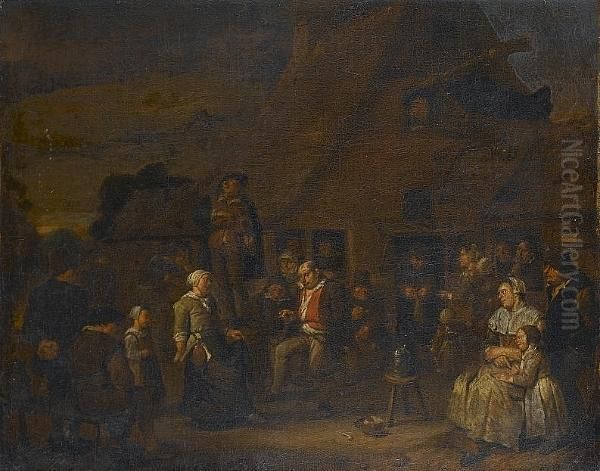
Bird Market: A genre scene depicting the activity of a marketplace focused on the selling of birds, typical of his interest in everyday commerce and social interaction.
The Dutch School (print, in collaboration with Isaac Beckett): A mezzotint based on one of his paintings, representing his involvement in printmaking and the dissemination of his popular imagery.
Numerous Tavern and Interior Scenes: While often untitled or generically titled (e.g., Tavern Interior, Peasants Merrymaking), these form the bulk of his genre output, characterized by lively figures, humor, and detailed settings.
Egbert van Heemskerck the Elder remains an important figure for understanding the breadth of Dutch Golden Age painting and its transmission to England. His work, particularly his insightful medical scenes and lively genre paintings, continues to engage viewers with its blend of realism, humor, and historical documentation.